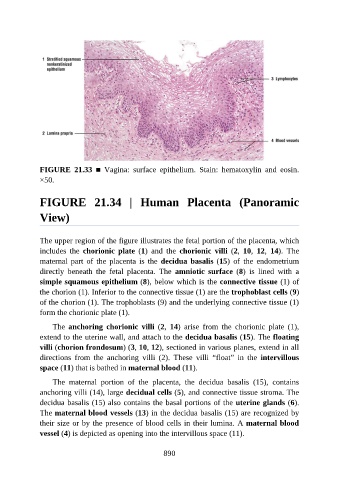Page 891 - Atlas of Histology with Functional Correlations
P. 891
FIGURE 21.33 ■ Vagina: surface epithelium. Stain: hematoxylin and eosin.
×50.
FIGURE 21.34 | Human Placenta (Panoramic
View)
The upper region of the figure illustrates the fetal portion of the placenta, which
includes the chorionic plate (1) and the chorionic villi (2, 10, 12, 14). The
maternal part of the placenta is the decidua basalis (15) of the endometrium
directly beneath the fetal placenta. The amniotic surface (8) is lined with a
simple squamous epithelium (8), below which is the connective tissue (1) of
the chorion (1). Inferior to the connective tissue (1) are the trophoblast cells (9)
of the chorion (1). The trophoblasts (9) and the underlying connective tissue (1)
form the chorionic plate (1).
The anchoring chorionic villi (2, 14) arise from the chorionic plate (1),
extend to the uterine wall, and attach to the decidua basalis (15). The floating
villi (chorion frondosum) (3, 10, 12), sectioned in various planes, extend in all
directions from the anchoring villi (2). These villi “float” in the intervillous
space (11) that is bathed in maternal blood (11).
The maternal portion of the placenta, the decidua basalis (15), contains
anchoring villi (14), large decidual cells (5), and connective tissue stroma. The
decidua basalis (15) also contains the basal portions of the uterine glands (6).
The maternal blood vessels (13) in the decidua basalis (15) are recognized by
their size or by the presence of blood cells in their lumina. A maternal blood
vessel (4) is depicted as opening into the intervillous space (11).
890

